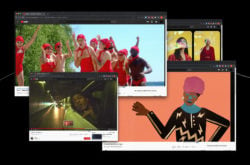Illustration: Benedikt Rugar
Sending out pitch emails to strangers is a special kind of hell.
If you’re an artist promoting your work, it can feel like you’re laying your heart out on display and then encouraging people to slowly stab it, over and over again. But for those who don’t have a publicist, a label, or a team advocating for your work, it’s sometimes a necessary act.
Perhaps it’s a good exercise in humility? I don’t know, to be perfectly honest.
I’ve been on both sides of the cold email exchange. I self-released an album in 2019 and set about doing my own publicity for it. I sent out so many pitch emails in the process, and sometimes I succeeded. For me, cold emails have led to press in major international outlets, useful label contacts, and exciting performance opportunities. It does work sometimes, and that’s why we as artists keep doing it.
As a journalist, I also receive many pitch emails. A lot of them are bad. Most of them shouldn’t have been sent to me at all, indicating that the sender didn’t do their research, as I don’t write music reviews.
Below, I break down how to write and send an effective cold email, what pitfalls to avoid, and how to maximize your likelihood of cold email success. When it’s done right, cold emailing can be a wonderful thing – a special moment of connection. The person you email could be a future friend or the results could be mutually fruitful. It just takes a bit of effort for cold emailing to have those types of results.
Here are components I’ve identified to writing a good cold email that’s likely to elicit positive results, without making you feel as though you’re subjecting yourself to a medieval torture device.
1. Make a plan and set boundaries
If you want to send successful cold emails, begin by defining what success looks like for you. Obviously, we’d all love to have everyone we email glowingly respond to our request, but that’s not very realistic. If you set out with that as your goal, you’ll likely be disappointed.
I’ve found that a 10 – 15% response rate is reasonable to expect if you’re taking the time to write good emails and send them to appropriate people. With that response rate in mind, what’s the total number of hours you’re willing to put toward sending pitch emails?
Come up with a plan and set time limits for yourself before you begin. Create a finite window during which you’ll be cold emailing. Plan specific dates and times to check in with yourself throughout the process to make sure it’s not wearing too heavily on your soul.
Include taking good care of yourself as part of your definition of success (not just for cold emailing, but always).
Think of cold emailing like fishing. When you go fishing, you cast lines out in hopes that something will bite, but you understand that you won’t bring home a fish every time. You find ways to appreciate the process whether or not you catch a fish – the calmness of nature, the feeling of the breeze, and the birds flying overhead.
Sending out cold emails isn’t as pleasant as drifting along in a dinghy with a fishing pole, but there are some things to enjoy about the process nonetheless. Take advantage of the opportunity to learn more about your field, improve your written communication skills, and even deepen your understanding of your own work by figuring out how to frame and present it to a wide range of people. Once you have a sense of what you’d like to get out of the process of cold emailing, even if you don’t catch a big fish, then you’re ready to begin.
2. Do your research
This should be a given, but make sure you’re sending your email to the right person. If you’re pitching to the music press, don’t blindly send emails to all of the Rolling Stone email addresses you can find. It’s a waste of everyone’s time, including yours.
Instead, be strategic about who you email. Take a moment to brainstorm artists who sound like you in some way or have a similar energy. Who is writing about them? Within that group, who’s doing thoughtful and engaged writing about those artists? Look them up on social media. Are they still at that same job, writing for that same publication? These are the people you want to approach.
The research stage is a little different when you’re reaching out to someone you want to have a more enduring partnership with, like a label, publicist, or booking agent. Be even more strategic and discerning about who you approach. Familiarize yourself with not only the artists they work with, but also their general tone and online presence. Do they seem kind? Do they seem engaged with the sort of music scenes that you operate within?
Do you personally know any artists on their roster? If so, talk to them about their experience. Get as much background information as possible. Then, if after all of that you’ve determined that they’re a good potential match, don’t email them yet. See if you can find someone who knows them who’d be willing to email them on your behalf.
For press stuff, I don’t think this step is necessary, but for long-term partnerships, having a personal connection make an introduction is extremely helpful. A lurky tip is to check out their social media friends / followers and see who you have in common. If there’s someone on there who you know personally (particularly someone who has an established interest in your music) and they seem like they might be this person’s friend in real life, reach out to them and ask them to make an intro.
3. Do more research and some guesswork
Once you’ve decided yes, this is the right person for me to email, and there isn’t anyone else who can email them on my behalf, then you’re ready to enter research phase two.
You need to tailor your cold email to your recipient. The same language and tone that’ll resonate for a 22-year-old writer at Paper won’t be effective for a 48-year-old editor at the New York Times. It’s critical that you thoughtfully consider the person you’re writing to as you begin to draft an email.
One successful cold email I sent was 95% composed of gifs from a music video of mine, interspersed with very short bits of text. This was based on my (accurate) perception that this particular editor was compelled by strong and bold visuals, and therefore, that would be the way to pique his interest. Sending an email full of gifs isn’t going to work for most people, but it did for him.
Draft your email with the specific interests of the recipient in mind and demonstrate in your email that it’s specifically being sent to them. It’s so easy to tell when you’re receiving a generic email that’s been sent to a bunch of people. A lot of people don’t even bother to fix obvious copy / paste incongruities with font, text size, and text color. Add personal details to the email to show that you’ve engaged with the person’s work, and don’t be afraid to flatter them or name-drop when appropriate.
Another part of research is finding the person’s email address. Lots of people don’t have their email address readily available online. When you need to reach that person, you may have to get a little creative.
As a rule, don’t send emails to people’s personal email addresses unless they make it publicly available and explicitly encourage being contacted that way, say on their Twitter bio. If you have trouble finding their professional email address, try finding the email address of anyone at their organization, and deduce what the email format is ( i.e. lastname.firstinitial@companyname.com). You can also try googling the person’s name and the word “contact” or “email.” Maybe these tips are obvious, but finding the right email address to reach someone at is, of course, an essential part of the process.
4. Write a compelling subject line
Getting the recipient to actually open your email is a major hurdle. Since your email is coming from an unknown address, it’s a good idea to have an intriguing subject line.
Don’t write your subject line in the style that a publicist would. Publicists often write subject lines like “X Artist Releases New Single off Forthcoming Record YZ,” which albeit factual, is very dry. It clearly lays out what the email contains so the recipient already has a fair idea of what’s to come if they open it.
Those sorts of subject lines work for publicists because they maintain ongoing relationships with press outlets. There’s often a baseline level of email address recognition. But you aren’t a publicist – you’re an artist. You’re looking to forge a real, human connection with this cold email recipient.
I find that a subject line that’s a touch mysterious is ideal for getting people to read the email. Your goal is to set yourself apart from the sea of emails this person is receiving. Can you inject personality into the subject line? Can you make it playful, but not too familiar? This person is a stranger and an email that pretends you know the person will come across as disingenuous.
Here are some examples of cold email subject lines I’ve sent that were successful:
- You are rapturously invited
- 🗺 Parallel Worlding, music v. architecture 🗺
- Time Sensitive: this music video was shot on the U.S./Mexico border crossing
- How Quickly Utopia Becomes a Nightmare, MoMA Ps1, sweet songbirds
This is not to say that this style of subject line will work for you, but part of your challenge will be to find a way to quickly evoke your own personality and creative vibe within a short bit of text.
Come up with a list of possible subject lines before you compose the actual email, and then review them after you’ve written the email to select which is best. Some people say that emails with emojis in the subject line are more likely to be opened. I think it probably depends on the nature of the sender and recipient, but if it feels fun for you, do it.
5. Be bold, informative, and brief
You want to keep the body of your cold email short. This is almost always true, though there are the rare people who enjoy receiving a fully fleshed out, lengthy missive. You’ll need to use your judgment and assume that 99% of the time, one or two short paragraphs is going to be an appropriate length for your email.
The body of your email should contain the following:
1. A distinctive and personalized greeting
- Don’t necessarily follow this format, but here’s a loose template: “Good morning __, Sending warm wishes your way from (metaphysical description of your present circumstances / physical location). I really enjoyed your recent X about artist Y, and especially appreciated relevant detail Z.”
- Try to avoid starting all your emails with “I hope you’re well today,” or “I hope this note finds you well.” The eyes glaze over. Start it out with some sort of identifying detail that the reader can immediately latch onto to make you a real human being to them.
2. An explanation of why you‘re emailing them
- This should not only clearly state the desired outcome of your email, but also indicate what action you would like the recipient to take (e.g. “Please listen to my new album and let me know if you’d be interested in doing PR for this album release cycle”).
3. The information and materials someone needs to make an informed decision about whether they can accommodate your request
- E.g. “Please take a listen to the record at this private SoundCloud link, or via this WeTransfer (embed hyperlinks on text), and peruse the information contained below to learn more about my work.”
4. A kind and sincere closing
It’s never a bad idea to thank someone for their time or to say something nice and genuine.
Then, after you’ve signed your name, include whatever other materials (within reason) this person will need to familiarize themself with your work. Include one photo if you wish, embedded within the email rather than as an attachment (make sure it’s a smaller file; otherwise you may have loading issues or your email may get flagged and sent to spam). Make sure to include all of the necessary links for the recipient to explore your work further.
If this is an email to a press person, you can include the equivalent of what would be in a press release after you close your email. Don’t attach a press release – plaintext is good. A lot of editors and writers will copy and paste directly from your press release if they write about it, so they don’t want to deal with a PDF. Here are some of my recent press releases if you could use an example.
6. Be mindful of timing when you send your cold email
If possible, I like to time cold emails so that they arrive in the recipient’s inbox right when they’re getting started with work that day. So generally, that’s between 8:00 AM and 10:00 AM, bearing in mind the time zone of the recipient. Of course, that’s not a hard-and-fast rule and everybody’s different. But in general, if you send an email at 6:00 PM on a Friday night, the odds are higher that your message is going to get lost in the shuffle.
I also think sending pitch emails is better earlier in the week when people are looking for more new items of discussion to bring to their pitch meetings. Again, this is not going to be the case for everybody, but it’s something to bear in mind.
7. Follow up once, and then let it go
Even with all of your careful research and thoughtful composition, be prepared for no response. It is what it is, unpleasant though it may be. Wait a week, and if you haven’t heard back from the person, send a follow-up email. Make it short and sweet. If you don’t get a response after that, then move on.
8. Be really nice to yourself at every stage of the process
It can be depressing to send out tenderly wrought emails knowing full well they’ll likely never yield a response. If you do it too much, it can mess with your head and even affect your confidence in your work.
Be mindful about how much time you dedicate to sending out cold emails and be realistic in your expectations. Cold emailing people is an uphill battle, and even more so during COVID-19 since much of the financial apparatus of the independent music industry has collapsed.
When I tried to do my own PR for my album ARDIS, I wanted to make a big impact with it. I believed in the project wholeheartedly and was devastated when I didn’t get a big response. I knew, consciously, that I shouldn’t take it personally, but in my zeal to do everything I could to make the album succeed, I pushed myself beyond a healthy point in terms of outreach. I learned a lesson from that and won’t do it again. But when it’s your own work, it can be hard to maintain healthy boundaries.
If you’ll be cold emailing people, check in with yourself often. Counter the process by doing something nice for yourself or something that invigorates the joy you get out of your work. Even take a moment and write yourself an email to tell yourself what a great job you’re doing.
Ultimately, you’re the one who validates your work, not a label, or a music publication, or any other arbiter of taste. You’re the one who defines what makes a release successful, not a number underneath your name on a streaming platform. As you’re writing cold emails, you’ll probably have to remind yourself of that more than once. Be nice to yourself, and if it’s starting to feel masochistic, then it’s time to stop.
Do you have any questions or tips about sending cold emails? Leave them in the comments below.
Explore royalty-free sounds from leading artists, producers, and sound designers:
January 11, 2021



